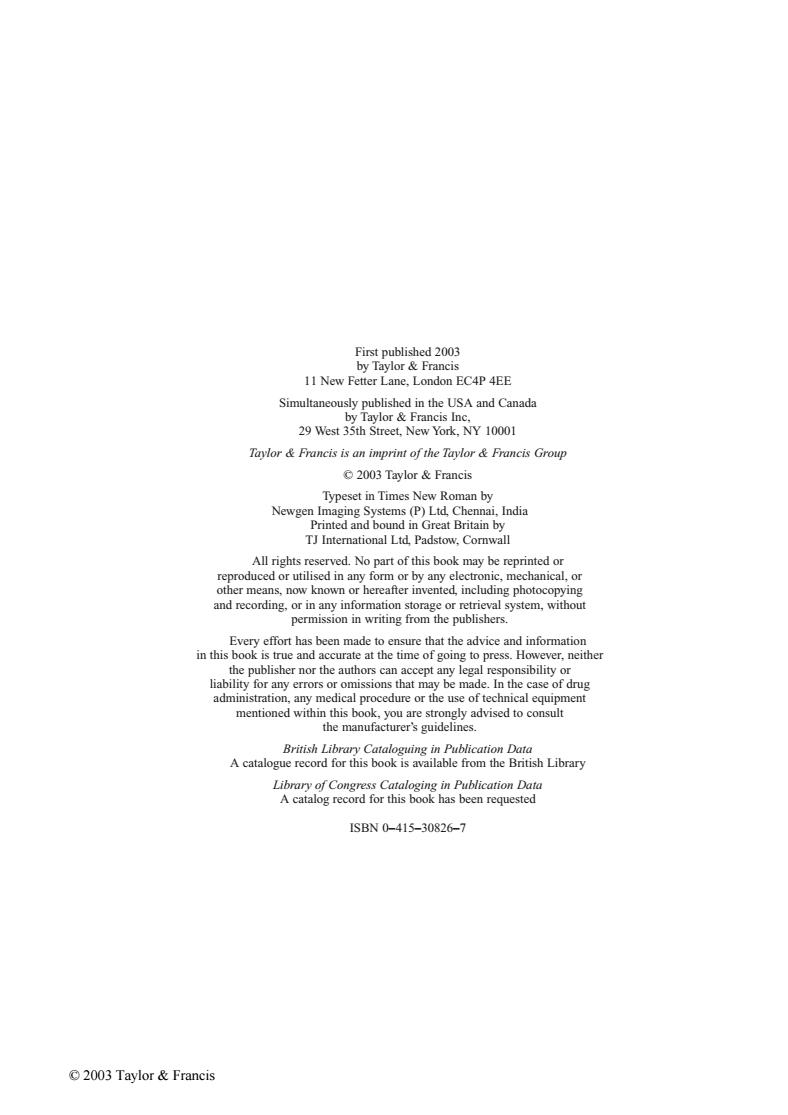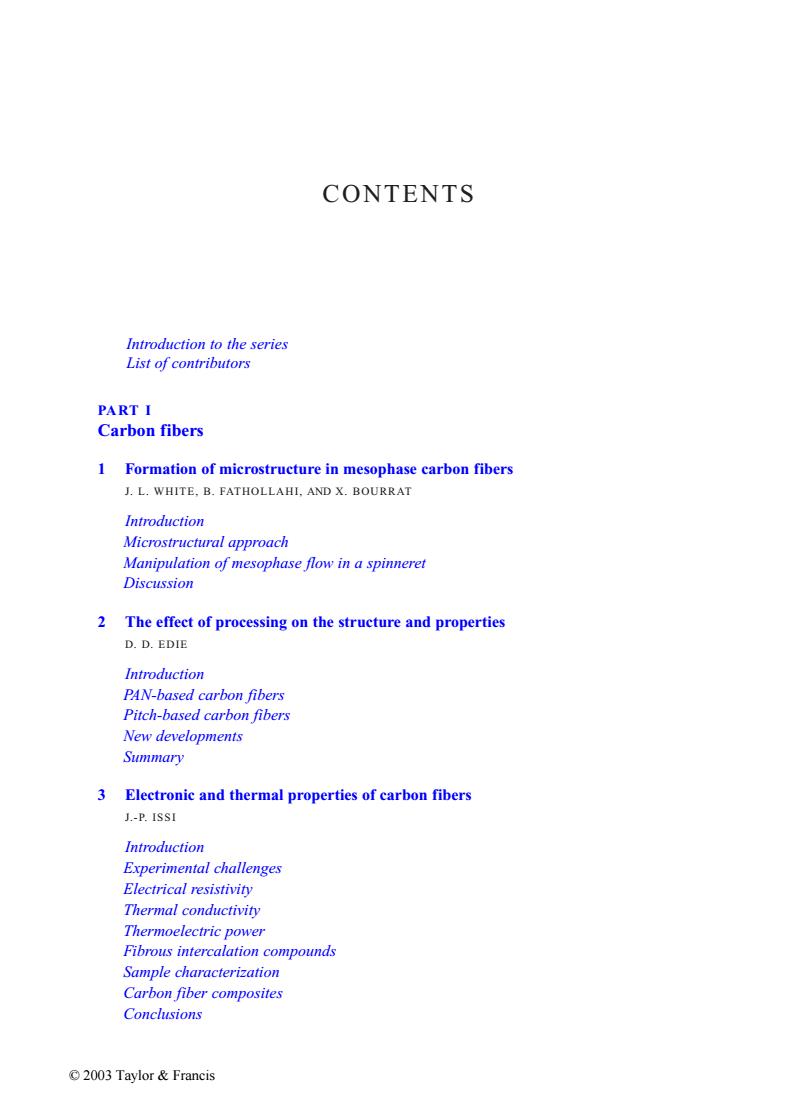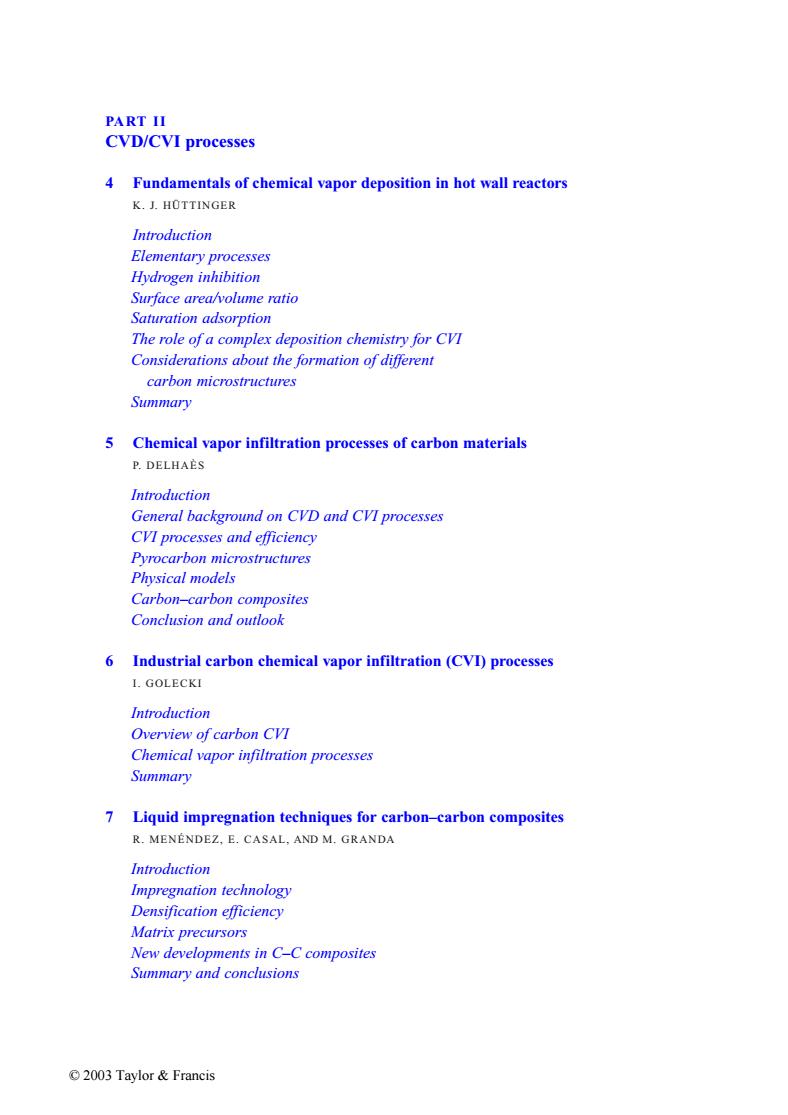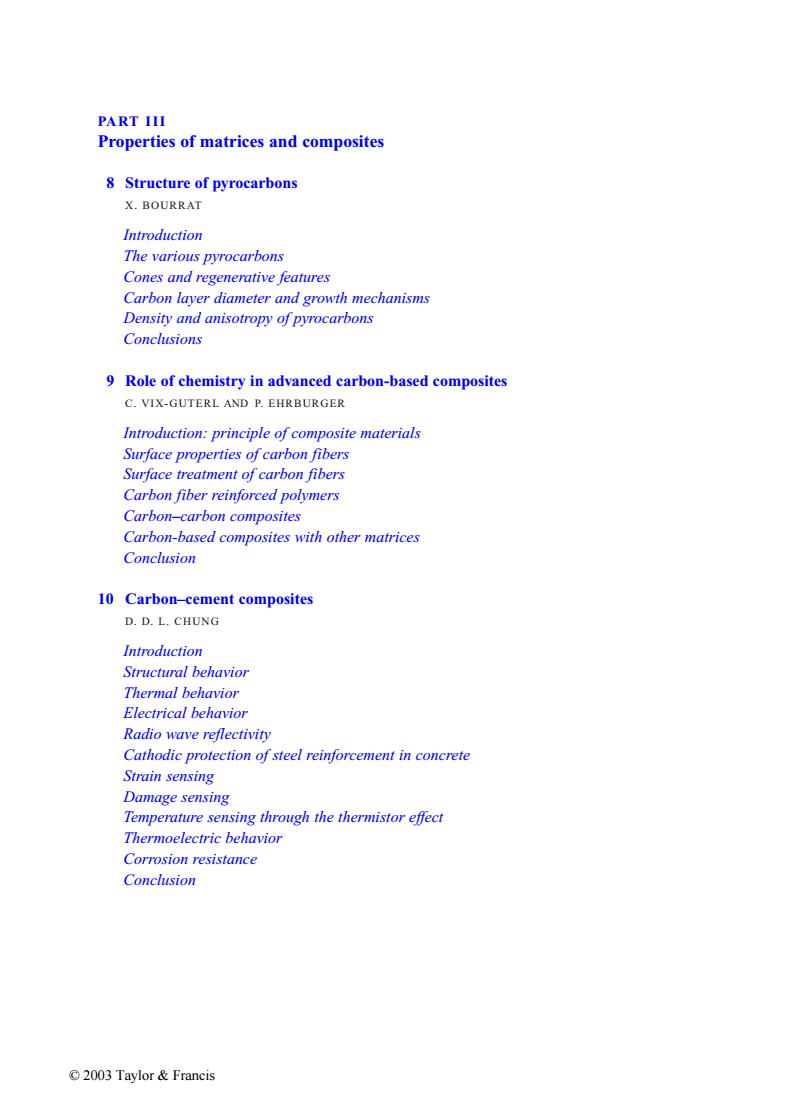
FIBERS AND COMPOSITES Edited by Pierre Delhaes Taylor Francis Taylor Francis Group LONDON AND NEW YORK ©2003 Taylor&Francis
FIBERS AND COMPOSITES Edited by Pierre Delhaès © 2003 Taylor & Francis

First published 2003 by Taylor Francis 11 New Fetter Lane.London EC4P 4EE Simultaneously published in the USA and Canada by Taylor Francis Inc, 29 West 35th Street,New York,NY 10001 Taylor Francis is an imprint of the Taylor Francis Group 2003 Taylor Francis Typeset in Times New Roman by Newgen Imaging Systems(P)Ltd,Chennai,India Printed and bound in Great Britain by TJ International Ltd,Padstow,Cornwall All rights reserved.No part of this book may be reprinted or reproduced or utilised in any form or by any electronic,mechanical,or other means,now known or hereafter invented,including photocopying and recording,or in any information storage or retrieval system,without permission in writing from the publishers. Every effort has been made to ensure that the advice and information in this book is true and accurate at the time of going to press.However,neither the publisher nor the authors can accept any legal responsibility or liability for any errors or omissions that may be made.In the case of drug administration,any medical procedure or the use of technical equipment mentioned within this book,you are strongly advised to consult the manufacturer's guidelines. British Library Cataloguing in Publication Data A catalogue record for this book is available from the British Library Library of Congress Cataloging in Publication Data A catalog record for this book has been requested ISBN0-415-30826-7 ©2003 Taylor&Francis
First published 2003 by Taylor & Francis 11 New Fetter Lane, London EC4P 4EE Simultaneously published in the USA and Canada by Taylor & Francis Inc, 29 West 35th Street, New York, NY 10001 Taylor & Francis is an imprint of the Taylor & Francis Group © 2003 Taylor & Francis Typeset in Times New Roman by Newgen Imaging Systems (P) Ltd, Chennai, India Printed and bound in Great Britain by TJ International Ltd, Padstow, Cornwall All rights reserved. No part of this book may be reprinted or reproduced or utilised in any form or by any electronic, mechanical, or other means, now known or hereafter invented, including photocopying and recording, or in any information storage or retrieval system, without permission in writing from the publishers. Every effort has been made to ensure that the advice and information in this book is true and accurate at the time of going to press. However, neither the publisher nor the authors can accept any legal responsibility or liability for any errors or omissions that may be made. In the case of drug administration, any medical procedure or the use of technical equipment mentioned within this book, you are strongly advised to consult the manufacturer’s guidelines. British Library Cataloguing in Publication Data A catalogue record for this book is available from the British Library Library of Congress Cataloging in Publication Data A catalog record for this book has been requested ISBN 0–415–30826–7 © 2003 Taylor & Francis

CONTENTS Introduction to the series List of contributors PART I Carbon fibers 1 Formation of microstructure in mesophase carbon fibers J.L.WHITE.B.FATHOLLAHI.AND X.BOURRAT Introduction Microstructural approach Manipulation of mesophase flow in a spinneret Discussion 2 The effect of processing on the structure and properties D.D.EDIE Introduction PAN-based carbon fibers Pitch-based carbon fibers New developments Summary Electronic and thermal properties of carbon fibers J.-P.ISSI Introduction Experimental challenges Electrical resistivity Thermal conductivity Thermoelectric power Fibrous intercalation compounds Sample characterization Carbon fiber composites Conclusions ©2003 Taylor&Francis
CONTENTS Introduction to the series List of contributors PART I Carbon fibers 1 Formation of microstructure in mesophase carbon fibers J. L. WHITE, B. FATHOLLAHI, AND X. BOURRAT Introduction Microstructural approach Manipulation of mesophase flow in a spinneret Discussion 2 The effect of processing on the structure and properties D. D. EDIE Introduction PAN-based carbon fibers Pitch-based carbon fibers New developments Summary 3 Electronic and thermal properties of carbon fibers J.-P. ISSI Introduction Experimental challenges Electrical resistivity Thermal conductivity Thermoelectric power Fibrous intercalation compounds Sample characterization Carbon fiber composites Conclusions © 2003 Taylor & Francis

PART II CVD/CVI processes 4 Fundamentals of chemical vapor deposition in hot wall reactors K.J.HOTTINGER Introduction Elementary processes Hydrogen inhibition Surface area/volume ratio Saturation adsorption The role of a complex deposition chemistry for CVI Considerations about the formation of different carbon microstructures Summary Chemical vapor infiltration processes of carbon materials P.DELHAES Introduction General background on CVD and CVI processes CVI processes and efficiency Pyrocarbon microstructures Physical models Carbon-carbon composites Conclusion and outlook 6 Industrial carbon chemical vapor infiltration (CVI)processes I.GOLECKI Introduction Overview of carbon CVI Chemical vapor infiltration processes Summary 7 Liquid impregnation techniques for carbon-carbon composites R.MENENDEZ,E.CASAL,AND M.GRANDA Introduction Impregnation technology Densification efficiency Matrix precursors New developments in C-C composites Summary and conclusions ©2003 Taylor&Francis
PART II CVD/CVI processes 4 Fundamentals of chemical vapor deposition in hot wall reactors K. J. HÜTTINGER Introduction Elementary processes Hydrogen inhibition Surface area/volume ratio Saturation adsorption The role of a complex deposition chemistry for CVI Considerations about the formation of different carbon microstructures Summary 5 Chemical vapor infiltration processes of carbon materials P. DELHAÈS Introduction General background on CVD and CVI processes CVI processes and efficiency Pyrocarbon microstructures Physical models Carbon–carbon composites Conclusion and outlook 6 Industrial carbon chemical vapor infiltration (CVI) processes I. GOLECKI Introduction Overview of carbon CVI Chemical vapor infiltration processes Summary 7 Liquid impregnation techniques for carbon–carbon composites R. MENÉNDEZ, E. CASAL, AND M. GRANDA Introduction Impregnation technology Densification efficiency Matrix precursors New developments in C–C composites Summary and conclusions © 2003 Taylor & Francis

PART III Properties of matrices and composites 8 Structure of pyrocarbons X.BOURRAT Introduction The various pyrocarbons Cones and regenerative features Carbon layer diameter and growth mechanisms Density and anisotropy of pyrocarbons Conclusions 9 Role of chemistry in advanced carbon-based composites C.VIX-GUTERL AND P.EHRBURGER Introduction:principle of composite materials Surface properties of carbon fibers Surface treatment of carbon fibers Carbon fiber reinforced polymers Carbon-carbon composites Carbon-based composites with other matrices Conclusion 10 Carbon-cement composites D.D.L.CHUNG Introduction Structural behavior Thermal behavior Electrical behavior Radio wave reflectivity Cathodic protection of steel reinforcement in concrete Strain sensing Damage sensing Temperature sensing through the thermistor effect Thermoelectric behavior Corrosion resistance Conclusion ©2003 Taylor&Francis
PART III Properties of matrices and composites 8 Structure of pyrocarbons X. BOURRAT Introduction The various pyrocarbons Cones and regenerative features Carbon layer diameter and growth mechanisms Density and anisotropy of pyrocarbons Conclusions 9 Role of chemistry in advanced carbon-based composites C. VIX-GUTERL AND P. EHRBURGER Introduction: principle of composite materials Surface properties of carbon fibers Surface treatment of carbon fibers Carbon fiber reinforced polymers Carbon–carbon composites Carbon-based composites with other matrices Conclusion 10 Carbon–cement composites D. D. L. CHUNG Introduction Structural behavior Thermal behavior Electrical behavior Radio wave reflectivity Cathodic protection of steel reinforcement in concrete Strain sensing Damage sensing Temperature sensing through the thermistor effect Thermoelectric behavior Corrosion resistance Conclusion © 2003 Taylor & Francis